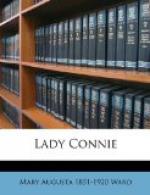Herbert Pryce was a young fellow and tutor—a mathematical fellow; and therefore, Alice’s father, for whom Greek was the only study worth the brains of a rational being, could not be got to take the smallest interest in him. But he was certainly very clever, and it was said he was going to get a post at Cambridge—or something at the Treasury—which would enable him to marry. Alice suddenly had a vague vision of her own wedding; the beautiful central figure—she would certainly look beautiful in her wedding dress!—bowing so gracefully; the bridesmaids behind, in her favourite colours, white and pale green; and the tall man beside her. But Herbert Pryce was not really tall, and not particularly good-looking, though he had a rather distinguished hatchet face, with a good forehead. Suppose Herbert and Vernon and all her other friends, were to give up being “nice” to her as soon as Connie Bledlow appeared? Suppose she was going to be altogether cut out and put in the background? Alice had a kind of uneasy foreboding that Herbert Pryce would think a title “interesting.”
Meanwhile Nora, having looked through an essay on “Piers Plowman,” which she was to take to her English Literature tutor on the following day, went aimlessly upstairs and put her head into Connie’s room. The old house was panelled, and its guest-room, though small and shabby, had yet absorbed from its oaken walls, and its outlook on the garden and St. Cyprian’s, a certain measure of the Oxford charm. The furniture was extremely simple—a large hanging cupboard made by curtaining one of the panelled recesses of the wall, a chest of drawers, a bed, a small dressing-table and glass, a carpet that was the remains of one which had originally covered the drawing-room for many years, an armchair, a writing-table, and curtains which having once been blue had now been dyed a serviceable though ugly dark red. In Nora’s eyes it was all comfortable and nice. She herself had insisted on having the carpet and curtains redipped, so that they really looked almost new, and the one mattress on the bed “made over”; she had brought up the armchair, and she had gathered the cherry-blossoms, which stood on the mantelpiece shining against the darkness of the walls. She had also hung above it a photograph of Watts “Love and Death.” Nora looked at the picture and the flowers with a throb of pleasure. Alice never noticed such things.
And now what about the maid? Fancy bringing a maid! Nora’s sentiments on the subject were extremely scornful. However Connie had simply taken it for granted, and she had been housed somehow. Nora climbed up an attic stair and looked into a room which had a dormer window in the roof, two strips of carpet on the boards, a bed, a washing-stand, a painted chest of drawers, a table, with an old looking-glass, and two chairs. “Well, that’s all I have!” thought Nora defiantly. But a certain hospitable or democratic instinct made her go downstairs again and bring up a small vase of flowers like those in Connie’s room, and put it on the maid’s table. The maid was English, but she had lived a long time abroad with the Risboroughs.




